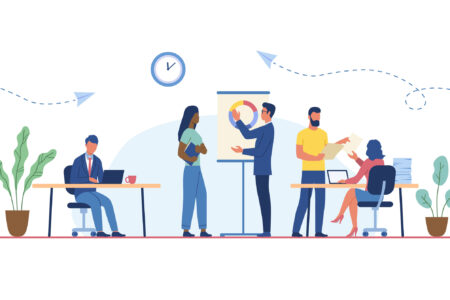
Share On Social!
Workforce diversity, equity, and inclusion (DEI) are top or high priority for 56% of local governments and K-12 schools according to a national online survey from MissionSquare Institute.
But less than half of these government and school leaders said they have strategic plans for DEI (26%) or formal programs or policies to help achieve DEI goals (41%).
The need for DEI action is rising alongside social justice movements like #BlackLivesMatter.
“DEI, which was once seen as a sub-component under the human resources department, has now evolved into a core business function that large and small businesses alike have been aggressively investing in,” writes Sarah Dong of GRC Insights. “Despite COVID-19’s effects on the U.S. economy, the number of DEI-related job postings increased by 123% between May and September of 2020.”
Let’s explore the state of DEI, barriers, impact on Latinos, and the future.
What Does DEI Mean?
The eXtension Foundation Impact Collaborative shares some good DEI definitions:
Diversity is the presence of differences that may include race, gender, religion, sexual orientation, ethnicity, nationality, socioeconomic status, language, (dis)ability, age, religious commitment, or political perspective. Populations that have been-and remain- underrepresented among practitioners in the field and marginalized in the broader society.
Equity is promoting justice, impartiality and fairness within the procedures, processes, and distribution of resources by institutions or systems. Tackling equity issues requires an understanding of the root causes of outcome disparities within our society.
Inclusion is an outcome to ensure those that are diverse actually feel and/or are welcomed. Inclusion outcomes are met when you, your institution, and your program are truly inviting to all. To the degree to which diverse individuals are able to participate fully in the decision-making processes and development opportunities within an organization or group.
“DEI in the workplace — relates to the actions taken to establish awareness and transform mindsets, behaviors, and practices to create and sustain a diverse, equitable and inclusive environment,” according to Saint Bonaventure University.
Achieving DEI has tremendous impact, experts say.
“Through cultivating an inclusive culture and empowering the diversity of people, organizations will lay the foundations to thrive, transform and future-proof themselves,” according to Kumar Parakala of the Forbes Technology Council. “Organizations that successfully deal with [DEI] matters will create a superhighway for their success, which can be measured both in terms of overall performance and customer satisfaction.”
What Is the State of DEI?
The MissionSquare report found that only 32% of the workforce mirrors the gender and race/ethnicity of the community, with only 32% of survey respondents feeling “very well” about gender and 30% feeling “very well” about racial/ethnic DEI.
Even the survey demographics from the MissionSquare report show that only 5% of survey responders, which consisted of local government human resource managers, were Latino. Of those in charge of DEI programs and policies, 89% are superintendents within K-12 school employers and 54% are city/county managers within local government employers.
The report also shows that when it comes to those in charge of DEI programs and policies, 89% are superintendents within K-12 employers and 54% is city/county managers within local government employers.
Of governments and schools that that have DEI programs and policies, a common focus is equitable treatment of employees (52%).
But tracking of impact is low.
Among government and school leaders that implement DEI programs, 61% reported that they track workforce diversity to some degree. Out that percentage, 12% were tracking in detail and 24% were tracking with limitations and another 24% were tracking it to a very limited extent.
“Whether it’s at the local or national level, diversity, equity and inclusion are fundamental to a flourishing society where all voices can be heard,” said United Way NCA.
How Does DEI Impacts Latinos in the Workforce?
Overall, 3 in 4 U.S. Latinos (78%) believe Latinos face bias in America today, compared to 55% of whites who say they face bias.
68.3% of Latinos are in the workforce, a greater percentage than the 63.6% of all Americans who are, according to a 2021 report by New American Economy.
A previous MissionSquare report shows that Latinos are underrepresented throughout different workforce industries including hospitals (-7%) and educational services (-5.1%).
A 2021 Workplace Inclusion & Equity Report found that 50% of Latino professionals have personally witnessed or experienced discrimination or bias at work. The same study reports that 63% of Latino professionals feel the burden of having to educate people on DEI.
The same report shows that Latino employees felt that their companies were making strides in diversity (41%).
However, there was still a need for more work in inclusion (20%) and equity (18%).
“The case is clear: diversity and inclusion increases company performance in nearly every metric that matters. Getting both elements right puts you at a significant competitive advantage,” according to Korn Ferry.
What Are the Barriers to DEI?
Many barriers face diverse candidates in the labor market.

“Barriers to implementing DEI program include lack of diverse candidates in the local labor market (87%); difficulty attracting or retaining diverse staff (85%); and factors related to the COVID-19 pandemic and ongoing Great Resignation, and difficulty attracting and retaining employees generally,” according to the MissionSquare report.
Other barriers to DEI include stereotyping and implicit bias, a gap in leadership skills, a “tick box” approach to promote diversity, low prioritization, and lack of meritocracy at the senior levels, according to Kumar Parakala of the Forbes Technology Council.
When asked if they believe people of all backgrounds can succeed at their organizations, Latino employees were 47% less likely than non-Latino individuals to feel they could succeed.
The Workplace Inclusion & Equity report further showed the barriers regarding freedom of expression in the work environment.
Latina women are 53% less likely than non-Latino professionals to feel comfortable expressing all aspects of their identity in the workplace.
“Fostering an inclusive environment where Hispanic/Latinx professionals feel freedom of expression requires an understanding of cultural differences and measures in place to examine your company’s corporate culture, policies and procedures for bias,” the research report mentions.
What Can Leaders Do to Improve DEI in the Workplace?
Leaders have a lot of options to begin improving diversity, equity, and inclusion, according to a September 2021 report from MissionSquare.
These include:
Designate a DEI officer, whether there are the resources to do so as a stand-alone position or a need to start with those duties added to an existing staff person’s responsibilities.
Evaluate the diversity of current staffing and areas where there’s room for improvement.
Think creatively about recruitment. Even if the local labor market may not include a wide range of diverse candidates, consider internships, hackathons, virtual project teams, and other strategies that can help build relationships across a wider region, raise awareness of career opportunities, and emphasize the value and satisfaction of working in public service.
Reach out to potential job candidates via proactive recruitment efforts, such as through HBCUs or HSIs, community groups, non-English language media and other specialty outlets, and military liaison offices.
Establish a regular engagement process for gathering employee input to assess not just overall satisfaction, but also issues around discrimination, equity, and inclusion.
Build an inclusion program, considering what employee resource groups, mentoring, or sponsorship opportunities might help diverse employees feel more engaged with the organization or among demographic or professional peers.
Add an equity lens to policy discussions to identify and eliminate potential differential treatment based on protected classes of employees or intersectional segments of the workforce (e.g., administrative vs. operational staff).
Don’t wait until exit interviews to find out there’s a problem that needs to be addressed.
“Through a commitment to regular evaluation of the impacts of its recruitment, hiring, pay, and promotion policies, employers can mitigate inequities, work toward a more effective recruitment and retention program, and build a diverse workforce that brings positive results in terms of employee morale, creativity, and productivity,” according to MissionSquare.
How Can Cities Address DEI?
Racism is a public health crisis.
Decades of racism-infused social, economic, and political systems have led to inequitable communities for Latinos and other people of color, who face high burdens of stress, disease, and premature death.
You can help local leaders declare racism a public health crisis and commit to change!
Download the free action pack, “Create a Meaningful Resolution on Racism as a Public Health Crisis,” from the Salud America! Latino health equity national program at UT Health San Antonio.
The action pack will help you connect with local advocates of color, draft a resolution, start a conversation with local leaders, and build support for a resolution to declare racism a public health crisis and take action for more equitable policies and practices.
“A resolution to declare racism a public health crisis can help local leaders identify and equitably change policies and practices across the board with input from community social justice advocates,” said Dr. Amelie G. Ramirez, director of the Salud America! program and the Institute for Health Promotion Research at UT Health San Antonio, who created the new action pack with input from national justice advocates. “This can be an important first step toward lasting, meaningful change to improve health equity for people of color.”
How Can You Speak Up for DEI?
Enter your county name and get a Salud America! Health Equity Report Card.
The report card is a data dashboard tool that auto-generates Latino-focused, local data with interactive maps and comparative gauges that compare to your state and nation. This can help you visualize and explore inequities in housing, transit, poverty, health care, food, and education.
You then can email report cards to local decision-makers, add data to your grants and projects, and more.
“You can share an interactive version of your local Health Equity Report Card to make the case to address existing inequities and strengthen your community’s ability to respond to and recover from disasters so everyone has a fair opportunity to live their healthiest lives possible,” Ramirez said.
By The Numbers
3
Big Excuses
people use to justify discriminatory behavior



